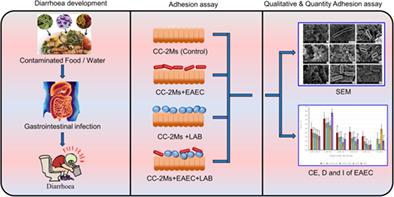当前位置:
X-MOL 学术
›
J. Food Saf.
›
论文详情
Our official English website, www.x-mol.net, welcomes your
feedback! (Note: you will need to create a separate account there.)
Presumptive probiotic bacteria from traditionally fermented African food challenge the adhesion of enteroaggregative E. coli
Journal of Food Safety ( IF 1.9 ) Pub Date : 2021-05-05 , DOI: 10.1111/jfs.12905 Wisdom Selorm Kofi Agbemavor 1 , Elna Maria Buys 1
Journal of Food Safety ( IF 1.9 ) Pub Date : 2021-05-05 , DOI: 10.1111/jfs.12905 Wisdom Selorm Kofi Agbemavor 1 , Elna Maria Buys 1
Affiliation

|
Colonization of intestinal tract with the potential to exclude, displace, and inhibit enteric pathogens is principally dependent on the adhesion ability of probiotics. Therefore, probiotic efficacy is considered to be mainly determined by their adhesion ability. The current study reports the antagonistic effect of four lactic acid bacteria (LAB) on the adhesion profile of four diarrhoeagenic and one non-diarrhoeagenic enteroaggregative Escherichia coli (EAEC). All the bacterial strains investigated adhered to the Caco-2 cells. All the LAB tested competitively excluded, displaced, and inhibited at least three (non-) diarrhoeagenic EAEC strains from adhesion (p < 0.05). In all, Lactobacillus plantarum, FS2 exhibited the strongest adhesion to the Caco-2 cells, competitive exclusion (CE), displacement, and inhibition against most of the EAEC strains. Additionally, the competence to exclude, displace, and inhibit the EAEC from adhesion depended on both the pathogens and the LAB strains tested; signifying the participation of several mechanisms. Contrary to all the EAEC strains, gastro-intestinal stress factors such as low pH (2.5) had no effect on the adhesion of the LAB. Unlike the gastro-intestinal acidic conditions, bile salt conditioning (at pH 6.5) had no effect on the adhesion of both EAEC and LAB. In conclusion, all the LAB tested showed specific anti-adherence effects including CE, displacement, and inhibition against the selected EAEC. The results indicate that all the LAB, particularly, the L. plantarum, FS2 had a good ability for exerting antagonistic effects against the selected EAEC for the prevention of gastrointestinal infection.
中文翻译:

来自传统发酵非洲食品的推定益生菌挑战肠道聚集性大肠杆菌的粘附
具有排除、取代和抑制肠道病原体潜力的肠道定植主要取决于益生菌的粘附能力。因此,益生菌的功效被认为主要取决于它们的粘附能力。目前的研究报告了四种乳酸菌 (LAB) 对四种致腹泻性和一种非致腹泻性肠聚集性大肠杆菌(EAEC)的粘附特性的拮抗作用。所有研究的细菌菌株都粘附在 Caco-2 细胞上。所有测试的 LAB 都竞争性地排除、取代和抑制至少三种(非)致泻性 EAEC 菌株的粘附(p < 0.05)。总之,植物乳杆菌, FS2 对 Caco-2 细胞表现出最强的粘附、竞争排斥 (CE)、置换和对大多数 EAEC 菌株的抑制。此外,排除、置换和抑制 EAEC 粘附的能力取决于病原体和所测试的 LAB 菌株。意味着多种机制的参与。与所有 EAEC 菌株相反,胃肠压力因素如低 pH (2.5) 对 LAB 的粘附没有影响。与胃肠道酸性条件不同,胆盐调节(pH 6.5)对 EAEC 和 LAB 的粘附没有影响。总之,所有测试的 LAB 都显示出特定的抗粘附作用,包括 CE、置换和对所选 EAEC 的抑制。结果表明,所有的 LAB,特别是植物乳杆菌, FS2 对选定的 EAEC 具有良好的拮抗作用,以预防胃肠道感染。
更新日期:2021-05-05
中文翻译:

来自传统发酵非洲食品的推定益生菌挑战肠道聚集性大肠杆菌的粘附
具有排除、取代和抑制肠道病原体潜力的肠道定植主要取决于益生菌的粘附能力。因此,益生菌的功效被认为主要取决于它们的粘附能力。目前的研究报告了四种乳酸菌 (LAB) 对四种致腹泻性和一种非致腹泻性肠聚集性大肠杆菌(EAEC)的粘附特性的拮抗作用。所有研究的细菌菌株都粘附在 Caco-2 细胞上。所有测试的 LAB 都竞争性地排除、取代和抑制至少三种(非)致泻性 EAEC 菌株的粘附(p < 0.05)。总之,植物乳杆菌, FS2 对 Caco-2 细胞表现出最强的粘附、竞争排斥 (CE)、置换和对大多数 EAEC 菌株的抑制。此外,排除、置换和抑制 EAEC 粘附的能力取决于病原体和所测试的 LAB 菌株。意味着多种机制的参与。与所有 EAEC 菌株相反,胃肠压力因素如低 pH (2.5) 对 LAB 的粘附没有影响。与胃肠道酸性条件不同,胆盐调节(pH 6.5)对 EAEC 和 LAB 的粘附没有影响。总之,所有测试的 LAB 都显示出特定的抗粘附作用,包括 CE、置换和对所选 EAEC 的抑制。结果表明,所有的 LAB,特别是植物乳杆菌, FS2 对选定的 EAEC 具有良好的拮抗作用,以预防胃肠道感染。











































 京公网安备 11010802027423号
京公网安备 11010802027423号